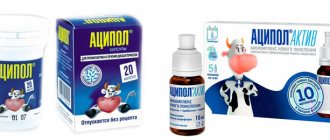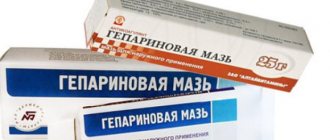Release form and composition
The following dosage forms of Pancreatin are produced:
- Enteric dragees: smooth, brown, with a shiny surface (in blisters of 10 pcs.; 5 blisters in a box);
- Enteric-coated tablets (in cans or bottles of 60 pcs., blister packs of 10 pcs.; 1 can, 1 bottle, 1, 2, 3, 5 or 6 packs in a cardboard pack).
1 tablet contains:
- Active ingredient: pancreatin with enzyme activity - proteolytic (200 FIP units (international units of enzymatic activity), amylolytic (3500 FIP units), lipolytic (4300 FIP units);
- Auxiliary components: chocolate brown dye, shellac, gum arabic, carnauba wax, white wax, diethyl phthalate, cellulose acetate phthalate, talc, sucrose, magnesium stearate, starch, glucose, lactose, polyvinylpyrrolidone.
1 tablet contains the active ingredient: pancreatin - 500 mg (with amylase activity - 12500 units (action units), protease - 12500 units, lipase - 1000 units).
Description of the drug
This drug has the same trade and nonproprietary names - “Pancreatin”.
The drug is a pink tablet, convex on both sides, with inclusions, covered with an enteric coating, with a specific odor. In a cross section of the tablets, two layers can be clearly seen. The active ingredient of the drug is pancreatin. Potato starch, calcium stearate, croscarmellose sodium, lactose monohydrate are used as auxiliary components in the tablets. The shell contains the following substances: titanium dioxide, azorubine dye (acid red 2C), methacrylic acid, ethyl acrylate copolymer, talc, povidone, macrogol.
How to Simply Recommend
Why the medicine does not work The key to successful treatment is, of course, following all the doctor’s recommendations and informing him of all significant changes during therapy. However, a specialist can talk as much as he wants about the regimen and duration of taking the drug, but most patients will still violate these rules. Read more
Indications for use
Dragee
- Chronic inflammatory-dystrophic diseases of the gallbladder, liver, intestines, stomach;
- Preparation for x-ray examination and ultrasound examination of the abdominal organs;
- Conditions after resection or irradiation of the gallbladder, liver, intestines, stomach, accompanied by diarrhea, flatulence, digestive disorders (as part of combined treatment);
- Insufficiency of exocrine pancreatic function (cystic fibrosis, chronic pancreatitis, etc.);
- Impaired digestion of food in patients with normal gastrointestinal function in cases of a sedentary lifestyle, disorders of chewing function, and dietary errors.
Pills
- Chronic pancreatitis;
- Chronic enterocolitis;
- Anacidic and hypoacid gastritis;
- Hypofunction of the pancreas;
- Dyspepsia due to diseases of the liver and pancreas.
Contraindications and side effects
Pancreatin is not recommended for use during pregnancy, but this item is not included in the list of official contraindications. It is prohibited to take it if you are individually sensitive to the components of the composition, as well as with a number of diseases. You should not drink Pancreatin if:
- Acute pancreatitis;
- Period of exacerbation of chronic pancreatitis;
- Acute hepatitis;
- Intestinal obstruction;
- Empyema of the gallbladder;
- Hyperbilirubinemia;
- Liver failure, precoma and coma;
- Obstructive jaundice;
- Cholelithiasis;
- Glucose-galactose malabsorption syndrome.
Whether it is possible to drink Pancreatin during pregnancy should be decided by the attending physician. He will study the characteristics of the condition and make a decision depending on the potential danger to both the mother and the fetus. Pancreatin is prescribed to children if the child is over six years old, with the exception of the Pancreatin 8000 form, it can only be used by adults.
Side effects from treatment occur less frequently than once in ten thousand cases, but are still possible:
- Allergic reactions due to intolerance to components;
- Hyperuricosuria or cystic fibrosis in cases of overdose;
- Constrictions in the initial part of the colon and ileocecal region;
- Pain in the epigastric region;
- Diarrhea;
- Changes in stool;
- Constipation;
- Nausea;
- Discomfort in the stomach;
- Intestinal obstruction.
In children, irritation of the oral mucosa may occur as a side effect. In general, almost all negative consequences develop if a person neglects the dosage prescribed for him. If you follow your doctor's instructions, problems almost never arise.
Pancreatin should be taken during pregnancy only as recommended by a doctor.
Directions for use and dosage
Dragee
Dragees are taken orally, without chewing, during or after meals.
The dosage of Pancreatin for adults is 1-3 pcs. 3 times a day; for children - determined by the doctor on an individual basis.
The duration of therapy ranges from several days (in cases of disruption of the digestive process due to dietary errors) to several months or years (continuous replacement treatment).
Pills
The tablets are taken orally.
The dosage of Pancreatin for adults is 500-1000 mg, for children – 100-500 mg 3-5 times a day.
Composition (active ingredient) "Pancreatin"
The round-shaped pills are green on the outside and covered with an intestinal-soluble coating. Inside, the tablet has a white or slightly yellowish composition. They also produce another type of “Pancreatin” - a dragee in a brown shell, which when broken is white with a brownish tint. The pills may have a not entirely pleasant odor.
The enzyme agent contains three main substances.
These are pancreatic enzymes:
- lipase;
- amylase;
- protease.
There are also compounds that do not have a therapeutic effect, but are designed to create a medicinal mass. Pancreatin tablets are available in 125 mg, 250 mg (can be designated as 25 units).
special instructions
The drug is not recommended for use during exacerbation of chronic diseases. Other special instructions from the instructions:
- For cystic fibrosis, the dosage is calculated based on the amount of enzymes necessary for the absorption of fats, taking into account the quality and quantity of food taken. It is not recommended to take the medicine at a dose of more than 10 thousand units per kg of a person’s weight per day, because the risk of developing strictures (fibrotic colonopathy) in the ileocecal part of the intestine increases.
- If the lipase in the drug is highly active, children have an increased risk of developing constipation. The dose is increased gradually.
- With hypersensitivity to pancreatin, meconium ileus, intestinal resection, digestive system disorders may occur.
- To prevent the formation of uric acid stones in the bladder, the uric acid content should be controlled.
- The drug contains active enzymes that can damage the oral mucosa. The tablets are swallowed whole without chewing.
- During long-term treatment with the drug, iron supplements are simultaneously indicated.
- When taking the medication before meals, it is washed down with alkaline liquids, Borjomi mineral water or sodium bicarbonate solution containing 0.5-1% active substance.
- Taking the drug does not affect the ability to concentrate and control machinery or transport.
User reviews
Reviews about the drug rarely indicate side effects. As a rule, pancreatin has a beneficial effect on digestion. Most often, people resort to using the drug without a prescription after holidays, when the amount of fatty or heavy food eaten exceeds the “standard” one. Vomiting, nausea, and diarrhea are rarely observed after taking the medicine.
Many reviews about pancreatin are left by parents of children who have indigestion. A common mistake among adults is dividing the tablets into parts, since the dosage needs to be reduced. However, you should not divide the drug “by eye”, especially since it will destroy the tablet shell. It is better to choose a convenient dosage or capsule form.
Instructions for using the drug for children
Pancreatin is prescribed to children based on diagnosis and age. With insufficient production of enzymes in children, food is poorly digested, regular diarrhea and hypovitaminosis develop.
For children under one and a half years old, the drug is recommended in a volume of 50 thousand units per day, and the indicated dose is divided by the number of meals.
From one and a half years to 12 years old, 100 thousand units per day are prescribed.
Adolescents from 12 years of age can be prescribed 200-400 thousand units per day.
Dosing of the drug for children should be done very carefully, since a sharp increase in the amount of medication taken leads to constipation.
There are different opinions regarding the prescription of Pancreatin for children. Some pediatricians are inclined to believe that the drug is harmful to a fragile body and is addictive. The pancreas in children stops producing enzymes on its own and gets used to receiving them from the outside. However, with congenital insufficient production of enzymes, pancreatin and its analogues can be the only salvation for the baby.
pharmachologic effect
The pancreatic enzymes that make up the drug are obtained from livestock, cattle and pigs.
These substances, entering the stomach, compensate for the insufficient activity of the pancreas in producing unique enzymes, which improves digestion.
Fats, proteins and carbohydrates are broken down faster (into amino acids, monosaccharides, fatty acids and dextrins) and are fully absorbed into the intestinal walls.
The coating covering the pills prevents the drug from acting in the stomach. The drug begins to disintegrate only in the duodenum. Thanks to the action of the substances, the digestive process is improved and the state of the gastrointestinal tract is normalized.









